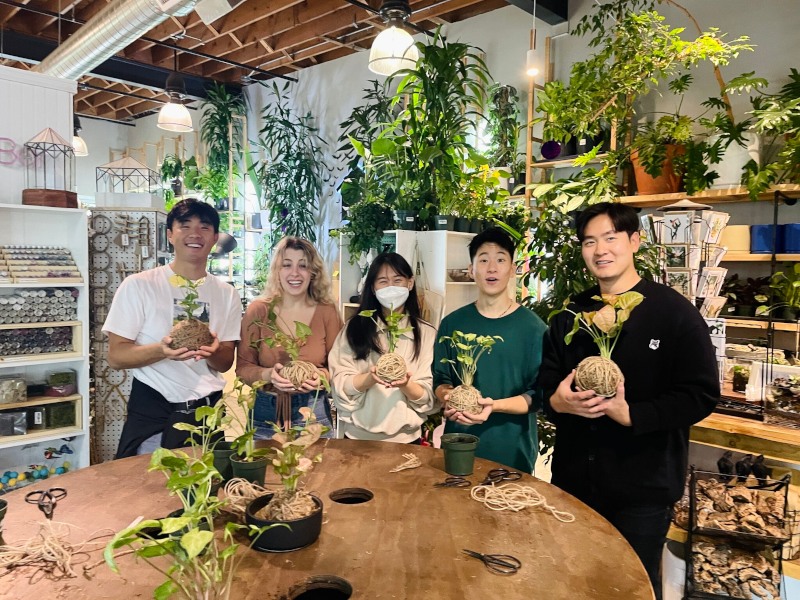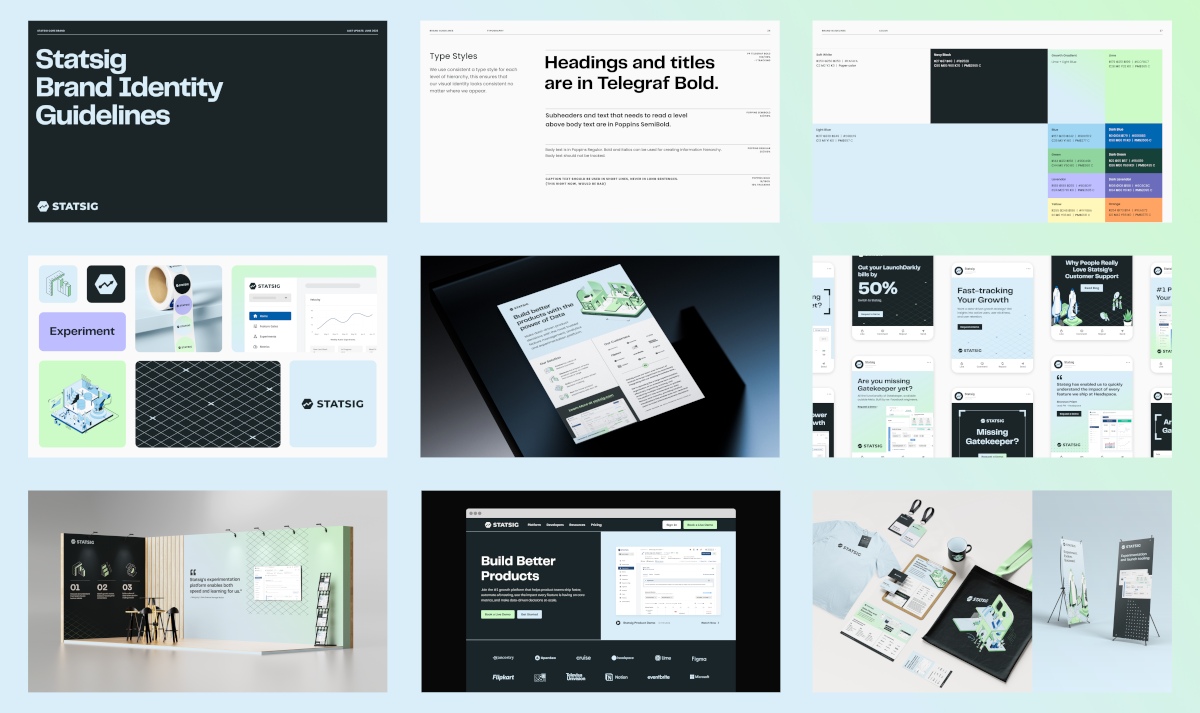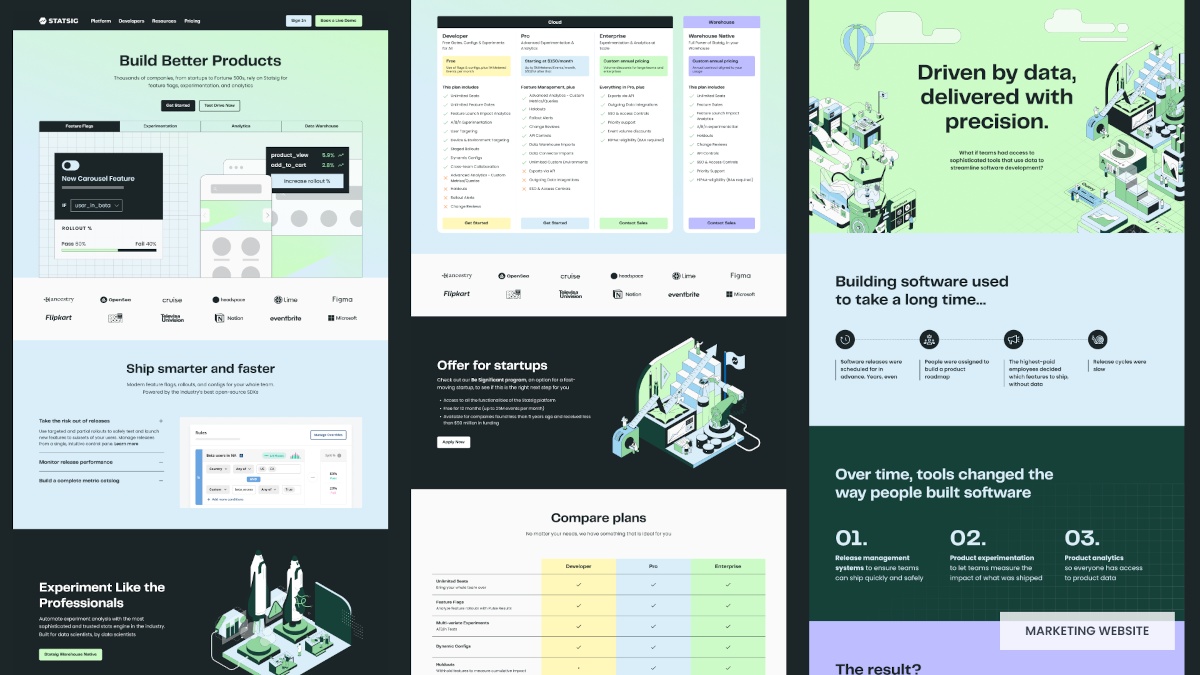
Designing at an early-stage startup is an experience like none other.
The year 2023 has swiftly passed at Statsig, as detailed in our latest blog post, "Statsig's 2023 Year in Review". Our design team has contributed much to this success, tirelessly working on launching numerous innovative product features and elevating our overall brand identity.
Designing anything at an early-stage startup is a lot of fun. There’s a ton of autonomy and opportunities to pioneer something new, establish standardized systems, and creatively explore in defining our product UI/UX and visual identity.
However, navigating the complexities of the B2B SaaS space for designers, particularly in the space of developer and data science tools, presents its unique challenges.
Author's note: I want to extend my heartfelt congratulations to every member of our design team for their exceptional efforts throughout the year. Their dedication, relentless spirit, and commitment to design excellence have played a pivotal role in elevating Statsig to new heights. Their hard work has not only contributed to our current success but has also set a solid foundation for our future endeavors.
The team continues to grow
At the start of 2023, our design team consisted of four full-time members: three focusing on product design and one on brand design.
Now, our team has grown to six, comprising four product designers and two brand designers. We're excited that two of our past Summer interns will be joining us full-time soon, bringing our total team size to eight.

Looking ahead, we have an extensive array of product features to design and develop (haha when did we not?).
Additionally, we're gearing up for numerous thrilling branding and marketing initiatives. Our pace is exhilarating—we work at lightning speed, and sometimes it feels like our Figma files can hardly keep up with our rapid design progress.
I'm incredibly enthusiastic about what we'll accomplish in 2024. But before we dive into the new year, I'd like to take a moment to reflect on and share our achievements from the past year.

2023's brand evolution
At Statsig, as a B2B SaaS platform, we develop product features that resonate with the specific needs of our potential customers.
The demand for feature flagging, experimentation, and analytics is already out there, with many users currently relying on in-house solutions or tools offered by our competitors. Raising awareness about our product, getting included in proof of concept (POC) processes, and ultimately persuading customers to choose Statsig requires a varied and comprehensive strategy.
It's a vital mission that involves every team member, each bringing their own unique skills and roles to the effort.
Why brand, why now?
In brand design, our focus is on elevating how we present ourselves externally.
This encompasses everything from the advertisements we run and the content we share on social media, to the webinars and events we organize, both online and offline. We're constantly seeking innovative ways to make a lasting impact, ensuring our brand resonates with and is easily recognizable to our customers, whether it's through sales materials, in-product experiences, or other key assets.

It's amazing to think that Statsig, founded less than three years ago, has already gained traction with globally renowned companies and rapidly growing startups.
As word about us spreads worldwide, we're seeing an increasing recognition of our brand and the power of our product. This has inspired us to invest more in enhancing our brand presence and growing our reach, ensuring we continue to build our visibility and attract new customers.
Brand design guidelines and visual identity
When assessing our competitive landscape, we found a diverse mix of companies, some with over a decade of experience and others—like us—newer to the scene. A detailed analysis of their branding, spanning website visuals, social media posts, advertisements, and more, revealed a significant opportunity for Statsig to differentiate itself and cultivate a unique identity.
Over a few months, our team worked on creating a new brand identity for Statsig, a journey we then shared with our entire company.
📖 Read the update: Introducing Statsig’s new visual identity.
With the successful establishment of our new brand design guidelines and visual identity in 2023, we began updating our existing assets to align with this refreshed style today, and I’m proud to share them below:

Our goal was multifaceted: to showcase the modernity of our tool, positioning ourselves as the innovative newcomer with a mature, seasoned approach.
We aimed to demonstrate the sophistication and expertise of our team, ensuring that our brand is both standout and memorable. We aimed to strike a balance between professionalism and playfulness, infusing our unique brand voice and personality into every aspect of our visual identity.

Responsibilities and accomplishments
The brand design team at Statsig works together with many different teams across the company, and the process in which we work with other teams has rapidly matured as well.
Our primary partnership is with the marketing team, but we also collaborate with sales, product, and business operations. Here's a brief overview of the diverse projects our team executes on:
Marketing: Ads, online & offline event assets (conferences, events, webinars, tech talks), social posts, website, voice of customers, blog posts, billboards, slide decks
Sales: One/two pagers, sales enablement assets, customer onboarding deck
Product: Statsig documentation site, in-product illustrations
Internal: Office branding (posters, murals), swags, internal company events, miscellaneous projects
Below are some of the notable final outcomes of what we’ve accomplished that I’m excited to share as quick snippets:





The product design team continued to move fast in 2023
Our product design team at Statsig has always been deeply involved in developing new features, working closely with product managers, engineers, and data scientists.
We're not only adding features planned in our roadmap to enrich our product but also, responding to requests from current and potential customers.
It often feels like we're running a marathon at the pace and precision of a 100-meter sprint.

Contributing to strategic areas of focus for the company
Listing every single project our product design team completed last year is almost impossible, but what I'm really proud of is how well the team supported our key strategic areas.
We made some big decisions at the company, and our product and design teams quickly adapted to support these changes.
As highlighted in our year-in-review blog post, the team played a crucial role in launching several major initiatives, including our new free feature flags solution, warehouse native launch, analytics launch, and the new user experience onboarding, among others.

Keeping our quality high and sharing feedback regularly
At Statsig, our designers work together to create user-friendly and visually appealing product features.
Since I started working here, I have always advocated for the incorporation of both aesthetics and user-friendliness in our tools.
As Katie Dill from Stripe says, if a product looks great, it's more likely to be user-friendly, trusted, and successful. At Statsig, this distinct approach is not only a key selling point of our product but also a unique feature that sets us apart from our competitors.
As a growing startup, our teams are constantly working on a long list of planned features while also quickly creating new ones our customers ask for. This means our designers need to think creatively and keep up with our fast pace.
One of our biggest challenges is making sure Statsig stays easy to use. Even as we add new features quickly, we're still focused on keeping our standards high. We do this by listening to what our customers say, using our own product to find ways to improve it, and carefully considering each new request.
This way, we're not just fast, but also really good at what we do.

In 2023, our product design team initiated weekly cross-functional (XFN) design reviews, creating a collaborative space where engineers, product managers, and other project stakeholders could offer insights on our proposed solutions.
Our commitment extended beyond these meetings, as we actively sought early feedback on our progress. We also embraced direct engagement with our customers, joining calls, visiting their offices, and gathering in-product feedback, all in an effort to deeply understand and integrate their perspectives into our design process.
Embracing 2024 at Statsig for design
Looking ahead, 2024 is set to be a transformative year for Statsig.
We're gearing up for significant brand growth, expanding our global presence, and evolving our product in numerous ways. For our design team, this means staying actively engaged and continuously pushing the boundaries of creativity and innovation.
As we persist in our pursuit of design excellence and maintaining high standards, all while keeping up with the rapid pace of our cross-functional teams, there are a few key areas I'd like the team to focus on as we grow:
Efficiency: With our product teams rapidly developing new features, it's essential for our designers to be efficient in managing time and prioritizing tasks. We need to refine our approaches to project progression, feedback exchange, and confidence in our deliverables.
Consistency: Our design system and brand guidelines are crucial for speed and visual uniformity. As our team expands, it's important to educate new members and evolve our systems as needed. Consistency is vital for maintaining simplicity and cohesion for our customers and aligning with our fast-paced internal culture.
Scalability: Designing for both new and existing platforms requires a balance between creative freedom and thoughtful consideration of scalability. While innovative solutions are encouraged, we must ensure these fit seamlessly into our overall system, preventing future complexity or confusion.
Balance between pragmatism and idealism
Statsig is an early-stage startup in Series B that was founded just less than three years ago. Despite our rapid success and growth, our daily reality is a continuous hustle for survival and progress.
Our situation differs markedly from larger tech companies with their abundant resources, specialized roles like user experience research (UXR) or content design, and established design principles that shape a culture of design. At Statsig, our designers need to adopt a pragmatic approach, focusing on what's essential for daily impact and contributing to our company's growth consistently.
Looking ahead though, I am excited about the potential evolution of Statsig's design function.
I envision a future where we delve deeper into how our design efforts serve our customers' needs and how we collaborate with other teams. Currently, these dynamics unfold organically within our close-knit team in Bellevue, where we work together every day.
As experts in our product, we must remember that our design choices have a significant impact on our customers. Therefore, while we don't require rigid frameworks, we must ensure that our designs effectively solve real problems.

Get started now!
